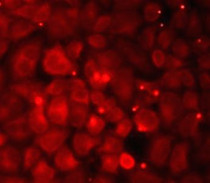ARG59382
anti-alpha A Crystallin antibody
anti-alpha A Crystallin antibody for ICC/IF,Western blot and Human,Mouse,Rat,Zebrafish
Overview
| Product Description | Rabbit Polyclonal antibody recognizes alpha A Crystallin |
|---|---|
| Tested Reactivity | Hu, Ms, Rat, Zfsh |
| Tested Application | ICC/IF, WB |
| Host | Rabbit |
| Clonality | Polyclonal |
| Isotype | IgG |
| Target Name | alpha A Crystallin |
| Antigen Species | Human |
| Immunogen | Recombinant fusion protein corresponding to aa. 1-173 of Human alpha A Crystallin (NP_000385.1). |
| Conjugation | Un-conjugated |
| Alternate Names | CRYA1; HSPB4; CTRCT9 |
Application Instructions
| Predict Reactivity Note | Zebrafish | ||||||
|---|---|---|---|---|---|---|---|
| Application Suggestion |
|
||||||
| Application Note | * The dilutions indicate recommended starting dilutions and the optimal dilutions or concentrations should be determined by the scientist. | ||||||
| Positive Control | Mouse kidney | ||||||
| Observed Size | 23 kDa |
Properties
| Form | Liquid |
|---|---|
| Purification | Affinity purified. |
| Buffer | PBS (pH 7.3), 0.02% Sodium azide and 50% Glycerol. |
| Preservative | 0.02% Sodium azide |
| Stabilizer | 50% Glycerol |
| Storage Instruction | For continuous use, store undiluted antibody at 2-8°C for up to a week. For long-term storage, aliquot and store at -20°C. Storage in frost free freezers is not recommended. Avoid repeated freeze/thaw cycles. Suggest spin the vial prior to opening. The antibody solution should be gently mixed before use. |
| Note | For laboratory research only, not for drug, diagnostic or other use. |
Bioinformation
| Database Links | |
|---|---|
| Gene Symbol | CRYAA |
| Gene Full Name | crystallin alpha A |
| Background | Mammalian lens crystallins are divided into alpha, beta, and gamma families. Alpha crystallins are composed of two gene products: alpha-A and alpha-B, for acidic and basic, respectively. Alpha crystallins can be induced by heat shock and are members of the small heat shock protein (HSP20) family. They act as molecular chaperones although they do not renature proteins and release them in the fashion of a true chaperone; instead they hold them in large soluble aggregates. Post-translational modifications decrease the ability to chaperone. These heterogeneous aggregates consist of 30-40 subunits; the alpha-A and alpha-B subunits have a 3:1 ratio, respectively. Two additional functions of alpha crystallins are an autokinase activity and participation in the intracellular architecture. The encoded protein has been identified as a moonlighting protein based on its ability to perform mechanistically distinct functions. Alpha-A and alpha-B gene products are differentially expressed; alpha-A is preferentially restricted to the lens and alpha-B is expressed widely in many tissues and organs. Defects in this gene cause autosomal dominant congenital cataract (ADCC). [provided by RefSeq, Jan 2014] |
| Function | Contributes to the transparency and refractive index of the lens. Has chaperone-like activity, preventing aggregation of various proteins under a wide range of stress conditions. [UniProt] |
| Cellular Localization | Cytoplasm. Nucleus. Note=Translocates to the nucleus during heat shock and resides in sub-nuclear structures known as SC35 speckles or nuclear splicing speckles. [UniProt] |
| Calculated MW | 20 kDa |
Images (2) Click the Picture to Zoom In
-
ARG59382 anti-alpha A Crystallin antibody ICC/IF image
Immunofluorescence: HeLa cells stained with ARG59382 anti-alpha A Crystallin antibody.
-
ARG59382 anti-alpha A Crystallin antibody WB image
Western blot: 25 µg of Mouse kidney lysate stained with ARG59382 anti-alpha A Crystallin antibody at 1:1000 dilution.







